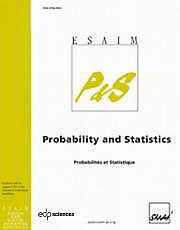Crossref Citations
This article has been cited by the following publications. This list is generated based on data provided by
Crossref.
Bon, Jean-Louis
and
Păltănea, Eugen
2001.
Convergence of the number of failed components in a Markov system with nonidentical components.
Journal of Applied Probability,
Vol. 38,
Issue. 4,
p.
882.
Ycart, Bernard
2001.
Complex Systems.
Vol. 6,
Issue. ,
p.
261.
Bon, Jean-Louis
and
Păltănea, Eugen
2001.
Convergence of the number of failed components in a Markov system with nonidentical components.
Journal of Applied Probability,
Vol. 38,
Issue. 4,
p.
882.
Paroissin, Christian
and
Ycart, Bernard
2004.
Central limit theorem for hitting times of functionals of Markov jump processes.
ESAIM: Probability and Statistics,
Vol. 8,
Issue. ,
p.
66.
Lachaud, B.
2005.
Cut-off and hitting times of a sample of Ornstein-Uhlenbeck processes and its average.
Journal of Applied Probability,
Vol. 42,
Issue. 4,
p.
1069.
Lachaud, B.
2005.
Cut-off and hitting times of a sample of Ornstein-Uhlenbeck processes and its average.
Journal of Applied Probability,
Vol. 42,
Issue. 4,
p.
1069.
Lachaud, Béatrice
and
Ycart, Bernard
2006.
Positive Systems.
Vol. 341,
Issue. ,
p.
169.
Barrera, Javiera
Lachaud, Béatrice
and
Ycart, Bernard
2006.
Cut-off for n-tuples of exponentially converging processes.
Stochastic Processes and their Applications,
Vol. 116,
Issue. 10,
p.
1433.
Barrera, J.
Bertoncini, O.
and
Fernández, R.
2009.
Abrupt Convergence and Escape Behavior for Birth and Death Chains.
Journal of Statistical Physics,
Vol. 137,
Issue. 4,
p.
595.
Chen, Guan-Yu
and
Kumagai, Takashi
2018.
Cutoffs for product chains.
Stochastic Processes and their Applications,
Vol. 128,
Issue. 11,
p.
3840.
Barrera, Gerardo
Högele, Michael A.
and
Pardo, Juan Carlos
2021.
The cutoff phenomenon in total variation for nonlinear Langevin systems with small layered stable noise.
Electronic Journal of Probability,
Vol. 26,
Issue. none,
Barrera, Gerardo
2021.
Cutoff phenomenon for the maximum of a sampling of Ornstein–Uhlenbeck processes.
Statistics & Probability Letters,
Vol. 168,
Issue. ,
p.
108954.
Barrera, G.
Högele, M. A.
and
Pardo, J. C.
2021.
Cutoff Thermalization for Ornstein–Uhlenbeck Systems with Small Lévy Noise in the Wasserstein Distance.
Journal of Statistical Physics,
Vol. 184,
Issue. 3,
Barrera, Gerardo
and
Högele, Michael A.
2023.
Ergodicity bounds for stable Ornstein–Uhlenbeck systems in Wasserstein distance with applications to cutoff stability.
Chaos: An Interdisciplinary Journal of Nonlinear Science,
Vol. 33,
Issue. 11,
Barrera, Gerardo
Högele, Michael A.
and
Pardo, Juan Carlos
2023.
The cutoff phenomenon for the stochastic heat and wave equation subject to small Lévy noise.
Stochastics and Partial Differential Equations: Analysis and Computations,
Vol. 11,
Issue. 3,
p.
1164.




